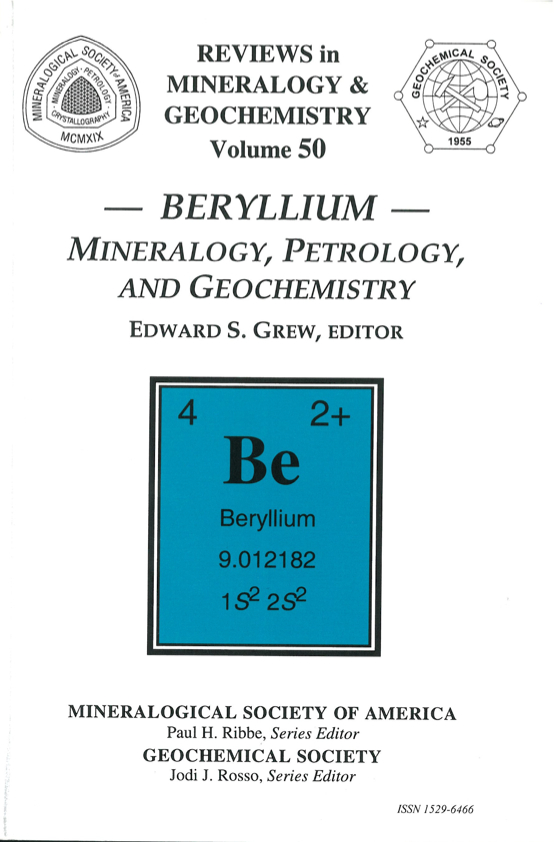

Mineralogical Society of America, Founded December 30, 1919
Order Publications Online (25% discount for MSA, CMS and GS members, except shipping)
MinPubs.org Pay-Per-View GeoScienceWorld Pay-Per-View


2002 i-xii + 691 pages. ISBN 0-939950-62-6; ISBN13 978-0-939950-62-1
This book has been several years in the making, under the experienced and careful oversight of Ed Grew (University of Maine), who edited (with Larry Anovitz) a similar, even larger volume in 1996: Boron: Mineralogy, Petrology, and Geochemistry (RiMG Vol. 33, reprinted with updates and corrections, 2002).
Many of the same reasons for inviting investigators to contribute to a volume on B apply equally to a volume on Be. Like B, Be poses analytical difficulties, and it has been neglected in many studies. However, with recent improvements in analytical technology, interest in Be and its cosmogenic isotopes has increased greatly.
Chapter 1 (Grew) is an overview of Be studies in the earth sciences backed by an extensive reference list, and an annotated list of the 110 mineral species reported to contain essential Be as of 2002, together with commentary on their status. A systematic classification of Be minerals based on their crystal structure is presented in Chapter 9 (Hawthorne and Huminicki), while analysis of these minerals by the secondary ion mass spectroscopy is the subject of Chapter 8 (Hervig). Chapter 13 (Franz and Morteani) reviews experimental studies of systems involving Be.
Chapter 2 (Shearer) reviews the behavior of Be in the Solar System, with an emphasis on meteorites, the Moon and Mars, and the implications of this behavior for the evolution of the solar system. Chapter 3 (Ryan) is an overview of the terrestrial geochemistry of Be, and Chapter 7 (Vesely, Norton, Skrivan, Majer, Kr·m, Navr·til, and Kaste) discusses the contamination of the environment by this anthropogenic toxin.
The cosmogenic isotopes Be-7 and Be-10 have found increasing applications in the Earth sciences. Chapter 4 (Bierman, Caffee, Davis, Marsella, Pavich, Colgan and Mickelson) reports use of the longer lived Be-10 to assess erosion rates and other surficial processes, while Chapter 5 (Morris, Gosse, Brachfeld and Tera) considers how this isotope can yield independent temporal records of geomagnetic field variations for comparison with records obtained by measuring natural remnant magnetization, be a chemical tracer for processes in convergent margins, and can date events in Cenozoic tectonics. Chapter 6 (Kaste, Norton and Hess) reviews applications of the shorter lived isotope Be-7 in environmental studies.
Beryllium is a lithophile element concentrated in the residual phases of magmatic systems. Residual phases include acidic plutonic and volcanic rocks, whose geochemistry and evolution are covered, respectively, in Chapters 11 (London and Evensen) and 14 (Barton and Young), while granitic pegmatites, which are well-known for their remarkable, if localized, Be enrichments and a wide variety of Be mineral assemblages, are reviewed in Chapter 10 (Cerny). Not all Be concentrations have obvious magmatic affinities; for example, one class of emerald deposits results from Be being introduced by heated brines (Chapters 13; 14). Pelitic rocks are an important reservoir of Be in the Earth's crust and their metamorphism plays a critical role in recycling of Be in subduction zones (Chapter 3), eventually, anatectic processes complete the cycle, providing a source of Be for granitic rocks (Chapters 11 and 12).
Ed Grew, University of Maine
2002
Title Page
p. i
Copyright
p. ii
Foreword & Cover Eplanation
p. iii - iv
Table of Contents
p. v - xii
Chapter 1. Mineralogy, Petrology and Geochemistry of Beryllium: An Introduction and List of Beryllium Minerals
by Edward S. Grew, p. 1 - 76
Chapter 2. Behavior of Beryllium During Solar System and Planetary Evolution: Evidence from Planetary Materials
by Charles K. Shearer, p. 77 - 120
Chapter 3. Trace-Element Systematics of Beryllium in Terrestrial Materials
by Jeffrey G. Ryan, p. 121 - 146
Errata for Chapter 3, Table 2 (omitted from text) pdf or html
Chapter 4. Rates and Timing of Earth Surface Processes From In Situ-Produced Cosmogenic Be-10
by Paul R. Bierman, Marc W. Caffee, P. Thompson Davis, Kim Marsella, Milan Pavich, Patrick Colgan, and David Mickelson, p. 147 - 206
Chapter 5. Cosmogenic Be-10 and the Solid Earth: Studies in Geomagnetism, Subduction Zone Processes, and Active Tectonics
by Julie D. Morris, John Gosse, Stefanie Brachfeld, and Fouad Tera, p. 207 - 270
Chapter 6. Environmental Chemistry of Beryllium-7
by James M. Kaste, Stephen A. Norton, and Charles T. Hess, p. 271 - 290
Chapter 7. Environmental Chemistry of Beryllium
by J. Vesely, S. A. Norton, P. Skrivan, V. Majer, P. Kram, T. Navr·til, and J. M. Kaste, p. 291 - 318
Chapter 8. Beryllium Analyses by Secondary Ion Mass Spectrometry
by Richard L. Hervig, p. 319 - 332
Chapter 9. The Crystal Chemistry of Beryllium
by Frank C. Hawthorne and Danielle M. C. Huminicki, p. 333 - 404
Chapter 10. Mineralogy of Beryllium in Granitic Pegmatites
by Petr Cerny, p. 405 - 444
Chapter 11. Beryllium in Silicic Magmas and the Origin of Beryl-Bearing Pegmatites
by David London and Joseph M. Evensen, p. 445 - 486
Chapter 12. Beryllium in Metamorphic Environments (Emphasis on Aluminous Compositions)
by Edward S. Grew, p. 487 - 550
Chapter 13. Be-Minerals: Synthesis, Stability, and Occurrence in Metamorphic Rocks
by Gerhard Franz and Giulio Morteani, p. 551 - 590
Chapter 14. Non-pegmatitic Deposits of Beryllium: Mineralogy, Geology, Phase Equilibria and Origin
by Mark D. Barton and Steven Young, p. 591 - 691